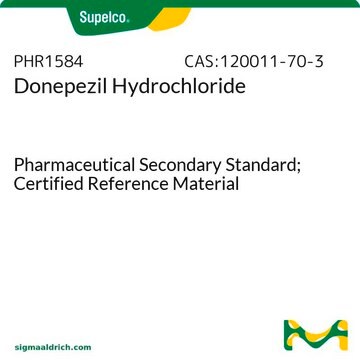S0929
Scopolamine hydrobromide
meets USP testing specifications
Synonim(y):
(−)-Scopolamine hydrobromide trihydrate, Hyoscine hydrobromide, Scopine tropate
About This Item
Polecane produkty
agency
USP/NF
meets USP testing specifications
Poziom jakości
mp
195-199 °C (dry matter) (lit.)
Zastosowanie
pharmaceutical (small molecule)
ciąg SMILES
O.O.O.Br.CN1[C@@H]2C[C@H](C[C@H]1[C@@H]3O[C@H]23)OC(=O)[C@H](CO)c4ccccc4
InChI
1S/C17H21NO4.BrH.3H2O/c1-18-13-7-11(8-14(18)16-15(13)22-16)21-17(20)12(9-19)10-5-3-2-4-6-10;;;;/h2-6,11-16,19H,7-9H2,1H3;1H;3*1H2/t11-,12-,13-,14+,15-,16+;;;;/m1..../s1
Klucz InChI
LACQPOBCQQPVIT-SEYKEWMNSA-N
informacje o genach
human ... CHRM1(1128)
Szukasz podobnych produktów? Odwiedź Przewodnik dotyczący porównywania produktów
Zastosowanie
- to reverse the cardiac effects of physostigmine in rabbit heart
- to study its effect on acoustic startle reflex (gap-PPI){148)
- to study it′s in vitro antiviral, antibacterial, and antifungal activities and cytotoxicity
- to study its effect on conditioning of lever pressing
Działania biochem./fizjol.
Hasło ostrzegawcze
Danger
Zwroty wskazujące rodzaj zagrożenia
Zwroty wskazujące środki ostrożności
Klasyfikacja zagrożeń
Acute Tox. 1 Dermal - Acute Tox. 2 Inhalation - Acute Tox. 2 Oral
Kod klasy składowania
6.1A - Combustible acute toxic Cat. 1 and 2 / very toxic hazardous materials
Klasa zagrożenia wodnego (WGK)
WGK 1
Temperatura zapłonu (°F)
Not applicable
Temperatura zapłonu (°C)
Not applicable
Środki ochrony indywidualnej
Eyeshields, Faceshields, Gloves, type P3 (EN 143) respirator cartridges
Choose from one of the most recent versions:
Certyfikaty analizy (CoA)
Don't see the Right Version?
If you require a particular version, you can look up a specific certificate by the Lot or Batch number.
Masz już ten produkt?
Dokumenty związane z niedawno zakupionymi produktami zostały zamieszczone w Bibliotece dokumentów.
Klienci oglądali również te produkty
Nasz zespół naukowców ma doświadczenie we wszystkich obszarach badań, w tym w naukach przyrodniczych, materiałoznawstwie, syntezie chemicznej, chromatografii, analityce i wielu innych dziedzinach.
Skontaktuj się z zespołem ds. pomocy technicznej











